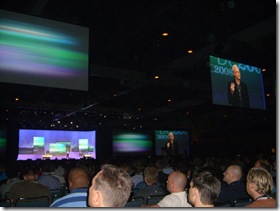Live Blogging at PDC 2008 – Ray Ozzie’s keynote: Introduce Windows Azure
Headline: Windows Azure, Windows in the Cloud, released as CTP
See the video stream here: www.microsoftpdc.com
Key theme: Transformation toward services, and enabling a new generation of apps that span the pc, web, and phone
Today: focusing on back end of that – data centers in the cloud
Some have recently asked, “Is the cloud overblown?” In a sense the concepts of utility computing was pioneered by service bureaus in the 1960s, as well as virtualization in the same period. But today, even in the best virtualized data centers, we’re serving and delivering inwardly facing solutions. they’ve been specifically built to target solutions for employees and in some cases partners. All scoped out, audited, and controlled by an IT organization skilled in management.
Now, every organization, school, government witnessing the externalization of IT. People are expecting more interactions with each other – community elements like wikis, ranking and rating, reviews, etc. The web a critical part of every company’s demand generation. Additionally, the previous separate world of software development and operations are more and more closely related.
For some customers, they see huge spikes in demand for computing capacity. Today, people ensure they have ample capacity for each application that has spikes in traffic. Spare power, cooling, compute, storage, network. And business continuity requires people to build multiple data centers in different locations. Far away customers have network latency issues that impact their experience and satisfaction. And to serve those far away, people build data centers all around the world which creates a host of other issues around tax and regulations.
So is the cloud different? Resoundingly yes. A system to serve the web is vastly different.
Over the years, we accumulated lots of knowledge on how to run high scale, robust technology infrastructure – but it has not been packaged in a form that is useful to developers or partners or customers.
And MS realized that we were seeing a new tier in computing architecture. Experience tier, data center tier, web tier. The web tier scale is the size of the web – apparently infinite capacity with available anywhere whenever needed. As we started planning for this, Amazon released EC2. Props to Amazon.
Windows Azure – a new windows offering at the web tier of computing. Vista, mobile at experience tier, windows server at server tier, and Windows Azure at web tier. Provides core capabilities: virtualized computing, storage, a fabric controller for handling geo distribution and management.
Balancing opposing goals:
On the one hand, help Windows developers reuse/leverage existing code and skills and tools and runtimes. It’s Windows, so you would expect a world of options for tools and runtimes. Being Windows, that’s the type of familiarity we intend to foster and grow.
We also need to help developers recognize that the cloud tier is fundamentally different. Most apps today and deeply rooted in a scale up past. The systems we’re building are setting the stage for next 50 years of computing. Windows Azure enables new deployment and app models, built for horizontal scale.
Windows Azure is not software you run on your own service. It’s a service that runs on MS machines. It’s released today as a CTP, and features are only a fraction of what you will eventually see. It’s designed for dynamic, rapid improvement.
Were betting on Azure ourselves. IT will be our highest scale, highest availability, most economically, and most environmentally sensitive way to host services in the cloud.
A few other services complement Windows Azure:
- Live Services – extend services outward to any pc, browser, phone in synchronized way
- .Net Services – service bus, workflow services, authorization services, identity federation services
- SQL Services – database services in cloud – reporting, business intelligence
- SharePoint Services – more coming
- Dynamics CRM services- more coming
- Windows Azure- includes compute, storage (tables, blobs, streams), and management
Technorati Tags: PDC 2008,Ray Ozzie,Windows Azure,cloud computing
